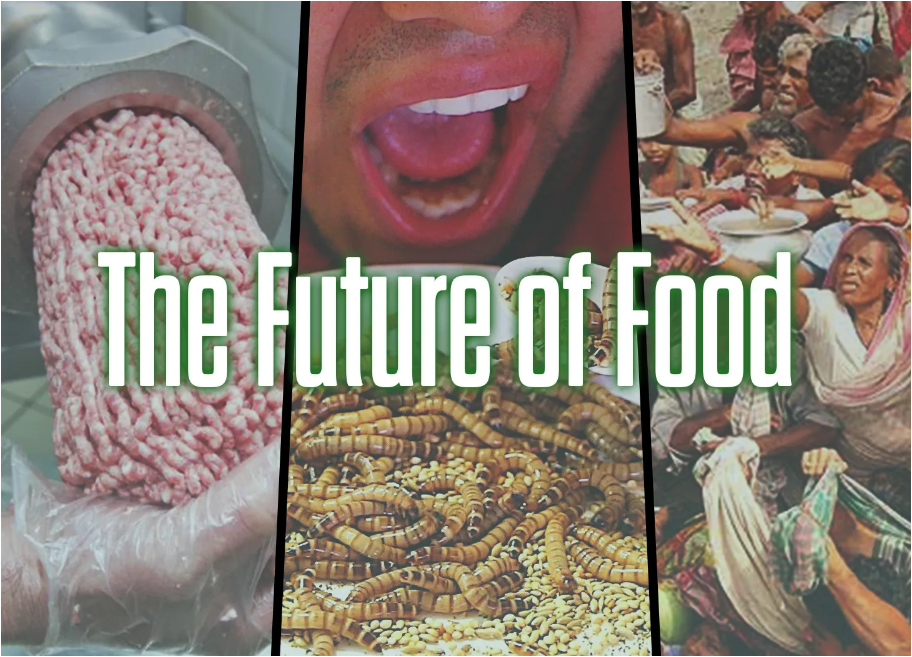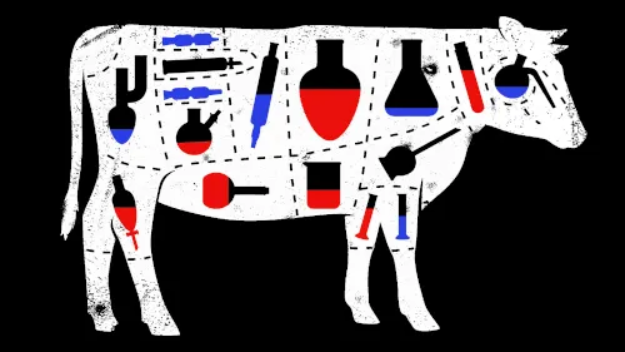
What is the Future of Food?
By James Corbett
If “you are what you eat,” as the old adage has it, then what does that make us?
As consumers of heavily processed, chemically treated, GMO-infested gunk, we in the modern, developed world have “solved” the problem of hunger that plagued our forebears since time immemorial by handing our food sovereignty over to a handful of corporate conglomerates. The result of this handover has been the creation of a factory farming system in which genetically engineered crops are doused in glyphosate and livestock are herded into tiny pens where they live their entire lives in fetid squalor, pumped up with antibiotics and growth hormones until they are slaughtered and shipped off to the supermarkets and fast food chains.
There have been any number of documentaries and exposés produced in recent decades detailing the dangers of this industrial farming system that we find ourselves beholden to, any number of activists ringing the alarm about these problems, any number of campaigns and marches organized to raise awareness about these issues. Yet still, nation after nation gets fatter and sicker as traditional diets based on fresh produce sourced from local farmers are displaced by the fast food pink slime sourced from the industrial farms of the Big Food oligopoly.
But as bad as things may be, they’re about to get even worse. As crisis after crisis disrupts the food supply, the “solution” to these problems has already been prepared. New technologies are coming online that threaten to upend our understanding of food altogether. Technologies that could, ultimately, begin altering the human species itself.
This is an exploration of The Future of Food.
Food As A Weapon

So what is food, anyway?
To a normal human being whose head is screwed on straight, that sounds like a dumb question. Food is fuel for the body, obviously.
Oh, sure, we could get fancy about it. Scientists might talk about the caloric content of different foods, or measure their macronutrient levels. Sociologists might point to food as the basis of human community, drawing people together into families, tribes and communities to break bread and engage in social relations. Theologians may even discuss the transubstantiation of bread and wine and the communion with God that such sacred acts of consumption make possible. . . .
. . . But then there are the psychopathic would-be world controllers. These Machiavellian schemers would define food in a very different manner. To them, food is a weapon.
There are no end of examples of food (or the lack thereof) being used as a method to manipulate and control populations throughout history.
For millennia, attacking armies have known that a city can be conquered by blockading it. Eventually, the besieged city’s inhabitants will run out of food and will either starve to death or surrender.
The English knew that food was a powerful tool of control. They created the conditions that led to the Irish Potato Famine and then stood idly by as millions died or were displaced, because—in the memorable words of Charles Trevelyan, who was in charge of the British government’s response—”the judgement of God sent the calamity to teach the Irish a lesson, that calamity must not be too much mitigated.” But the Irish were neither the first nor the last to feel the brunt of the British Empire’s indifference to their hunger; just ask the Bengals about their own famine.
The 20th-century example of this “food as a weapon” mindset that immediately springs to mind is the Holodomor, a brazen act of genocide perpetrated by Josef Stalin’s Soviets against the Ukrainians in order to squelch their budding independence movement. The ensuing famine resulted in the deaths of four million Ukrainians.
But the Holodomor is certainly not the only time that food was weaponized in the previous century. Even the official whitewash of American president Herbert Hoover by his namesake institution admits that Hoover weaponized food in pursuit of his geopolitical objectives—first by providing food to German-occupied Belgium and northern France during the First World War and then by his efforts to provide food aid to the Bolsheviks after the war. (Readers of Docherty and Macgregor’s Prolonging the Agony: How International Bankers and their Political Partners Deliberately Extended WW1, however, will know that there is a much deeper and darker story behind these efforts . . . but that is a story for another day.)
And who can forget arch-globalist Henry Kissinger’s National Security Study Memorandum 200: Implications of Worldwide Population Growth for U.S. Security and Overseas Interests? This now-infamous document—drafted by Kissinger in December of 1974 and adopted as official policy by President Ford in 1975—argues that since “[g]rowing populations will have a serious impact on the need for food,” food aid to the developing world may need to be tied to mandatory sterilization programs or population reduction quotas, prompting even the coolly calculating Kissinger to wonder whether such a scheme would turn food into “an instrument of national power.”
But that was then. This is now! Surely this “food as a weapon” idea has been retired, hasn’t it?
Lest there be any doubt that food is still being weaponized against us in the 21st century, one only has to turn to the latest news headlines to see that this idea is far from a relic of the past.
The COVID lockdowns demonstrated the fragility of the global industrial food supply chain, with closures and layoffs causing massive disruptions at meat processors and food distributors in countries around the world, from Canada to the UK to China to Japan. These closures caused havoc for supplies of milk, produce, rice and wheat everywhere. And this food supply pandemonium in turn caused headaches for farmers, truckers, supermarkets and restaurants and led to stampedes in Kenya and protests in Bangladesh and looting in Colombia and clashes in South Africa (not to mention supermarket freak-outs and shopping brawls in the US and Australia and the UK).
Then the Russian invasion of Ukraine kicked off a fresh round of global food insecurity. Ukraine harvested 19 million tonnes of wheat in 2022, down more than 40% from the previous year, and the smaller harvest means that cash-strapped Ukrainian farmers have fewer resources to invest in vital inputs like fertilizers, meaning that there is likely to be an even smaller harvest in 2023. This affects not only the countries like Egypt, Tunisia, Morocco, Indonesia, Pakistan and Bangladesh that rely on Ukraine for their wheat imports, but also poor countries in sub-Saharan Africa, whose flour derives from Ukrainian wheat processed in Turkey. It also drives up grain prices around the world, contributing to instability and food insecurity for millions.
All told, the shocks to the global food supply chain have contributed to a doubling in the number of people facing acute food insecurity since the start of the scamdemic.
Given this vivid demonstration of just how fragile the global food supply is and just how much economic and societal chaos can result from any shock to this system, it would be unthinkable that governments would now be deliberately attempting to undermine that supply chain further, wouldn’t it?
Well, think again. From the Netherlands to Ireland to Poland to Italy to Canada to Argentina to Sri Lanka, governments are cracking down on farmers, forcing them to cull herds, lower production, dump milk and comply with onerous new operating restrictions in the name of reducing pollution.
These governments are not stupid. Like the British, the Soviets, the Americans and other repressive regimes throughout history, they know that these measures, if played out to their conclusion, will result in widespread hunger and unrest. In fact, we’ve already seen massive protests against these restrictions in numerous countries, from Germany to Italy to Poland to Spain to Panama to Argentina to Canada. Dutch farmers made headlines for their dramatic protests last year, and Sri Lanka descended into chaos last summer, with protesters storming the capitol and causing the President to flee the country when it became obious that the Sri Lankan government’s own green policies and farming restrictions had contributed to the collapse of the nation’s economy.
But if this food crisis is being knowingly engineered, the question is why? What purpose would governments have for creating food shortages for their own people?
The answer is simple. We are witnessing a controlled demolition of the food supply chain, one that is intended to result in the destruction of the current industrial farming system as we know it. But this changeover is not intended to return us to truly sustainable farming practices, with local, organic farmers producing crops in accordance with age-old agricultural wisdom. Far from it.
As it turns out, the “solution” to this food crisis being proffered by the billionaires of the corporate-pharmaceutical-medical-industrial-philanthrocapital-military complex is being engineered in laboratories and sold to the public via a bought-and-paid-for mainstream media.
One thing is for certain: the future of food will look very different from anything that we have seen in human history.
The Future of (Weaponized) Food

Anyone who has been paying attention in recent years will already know the direction that the food industry is heading.
Yes, by now we all know the Eat Ze Bugs agenda being pushed by Klaus Schwaub and his Davos minions. I guarantee that wherever you are, in whatever corner of the world you are reading this editorial, you will have seen (or could easily find) a local news story about high school students “spontaneously requesting” cricket powder dumplings in their school lunch or a puff piece about how valiant scientists are working to save the world with worm burgers.
And we all know about the GMO problem: genetically modified organisms making their way into our food supply. We know about the multiple health studies that have proven time and time again the deleterious health effects of GMO consumption. We know about the insane lengths that the GMO giants have gone to to suppress bad news about their products and the insane lengths that the press has gone to to assist them in this cover-up. And we know about the additional harms that this technology causes, ruining farmer’s lives, contaminating the genome of the planet and causing associated products like glyphosate to further contaminate the food supply and further endanger our health.
But do we know about the next evolution in culinary technology? Now that scientists are playing around with the fundamental building blocks of life, reengineering organisms at the cellular level, an entire field of biotechnology is opening up that is threatening to fundamentally transform what we think of as food itself.
Moving beyond the simple insertion of foreign genes into an organism, scientists are now working on creating foodstuffs from designer microbes, engineering organisms into “bioreactors” that can be used to grow proteins and other materials for food production, growing meat-like products from cells in the laboratory and dozens of other zany ideas.
After a near-decade-long PR campaign, you’ve probably heard of Impossible Foods and Beyond Meat, companies that employ the latest techniques in chemical engineering to create plant-based meat substitutes. But there are many more technologies around the corner that threaten to transform our food supply in even more bewildering ways.
Scientists are bioengineering spores that can be inserted into crops and livestock, allowing companies to identify and track food products all the way through the food system, from farm to factory to fork.
DARPA is doling out multi-million-dollar contracts for researchers to find ways “to turn military plastic waste into protein powder” for human consumption.
A company called Amai Proteins is using genetically engineered microbes to create peptides that taste like sugar but are digested like proteins. And the best (read: worst) part is that, “[a]lthough these microbes are technically genetically engineered, the desired products can be purified and legally sold as non-GMO”!
And then there’s Indigo Ag, a Boston-based agricultural technology company that is ushering in The New Normal Of Agriculture by—as its thinly-disguised corporate PR masquerading as “investment news” likes to boast—”utilizing advanced AI and machine learning techniques to create a revolutionary agronomics platform that boosts farmland sustainability and productivity through next-gen microbiome treatments, digital regenerative content, time-series satellite imagery, advanced crop monitoring and data analysis, and grain quality testing” . . . whatever the hell that means.
Of course, these technologies will be sold to the public as a way to remarkably improve upon the boring old “food” that humanity has relied on for untold millennia. This isn’t food after all, this is Food 2.0!
Molecular gastronomy will allow for the creation of all sorts of zany and unimaginable dishes, from spherified juices to deep-fried hollandaise to lollipopified octopus!
In the nutrigenomical kitchen of the future, the AI systems that plan our meals and assemble our food will be able to precisely tailor our diet to our individual genome, calculating the exact portions of foodstuffs (or lab-grown food substitutes) we need to consume to meet our desired health goals!
And who needs a chef? In the future, we’ll bring the Star Trekkian idea of the replicator into reality by 3D printing all our food right in our own kitchen!
To get an idea of how this agenda is being sold to the middle managers of the global governmental class, look at this recent document from Policy Horizons Canada. Titled “Biodigital Today and Tomorrow,” it is a follow-up to their now-infamous 2020 document on Biodigital Convergence. This report aims to expand on that earlier paper by exploring “the potential impact of biodigital convergence on sectors such as health, food and agriculture, the environment, manufacturing, and security.”
When it comes to food, the folks at Policy Horizons Canada are positively ecstatic about the possibility for these new “biodigital” technologies (i.e., technologies blurring the line between biological life and digital machines) to reshape our food supply.
“Traditional agriculture relies on land, water, and a suitable climate,” the authors of the report lament before noting that “[i]n the future, foods could be manufactured anywhere in labs and indoor vertical farms.”
After discussing lab-grown foods, nutrigenomics and “smart” farming, the paper gushes about the incredible benefits of this technology. It will enable us to grow anything, any time, anywhere! It will allow countries to pursue food self-sufficiency by manufacturing those foods and ingredients that they can’t grow or raise themselves! It will allow us to reimagine our diet as a form of preventive healthcare! And, of course, it will save us from the deadly scourge of climate change!
The propaganda that is being rolled out to sell the public on this transformation of our food supply sounds like the sales pitch of a used car salesman. This should not be surprising. For those who know the players who are pushing this “Food 2.0” agenda and their real intentions, it is obvious that the enormous and unbelievably hubristic effort to replace natural food with laboratory-made food substitutes is not about helping the poor and starving to achieve food security, but rather to deprive them of the earth’s natural abundance. The end result will be a population dependent on the laboratory-produced food substitutes produced by a handful of oligopolistic corporations and a population at the mercy of the scientists these corporations employ. These molecular magicians will, after all, be able to insert all manner of exotic agents into the food supply at any time.
But to really understand where this agenda is heading and how quickly we are likely to get there if it is not opposed, we need look no further than the story of Future Fields. This company and its product has managed to combine the Unholy Trinity of fake food: GMOs, bugs and biotech.
Future Fields, a biotech company in (where else?) Canada, has notified the Canadian government of its intention to commercialize “EntoEngine,” a type of fruit fly that “has been genetically engineered to express a growth factor isolated from cows.” This growth factor, it turns out, is an important component of the lab-grown meat recipe, which has so far required the use of “fetal bovine serum” (FBS)—a substance extracted from unborn cattle—to grow the meat cells. But now that the “EntoEngine” has been created, Future Fields is excited to use these flying “bioreactors” to produce the growth factor faster and more cheaply than before.
Yes, bugs are being genetically modified to produce growth factor that is then used to grow meat cells in a lab. This is the future of food if the mad scientists and their billionaire funders get their way.
What Can We Do About This?
Thankfully, we are not passive spectators of this unfolding agenda; we are active participants, influencing the course of these events by the decisions that we make and the actions that we take.
Without understanding who is behind this agenda, however, or how it is being pushed, we can never hope to truly derail this Frankenfood nightmare.
To that end, next week we will explore the players who are pushing this agenda and the ways they are working behind the scenes to bring about their dietary dystopia.